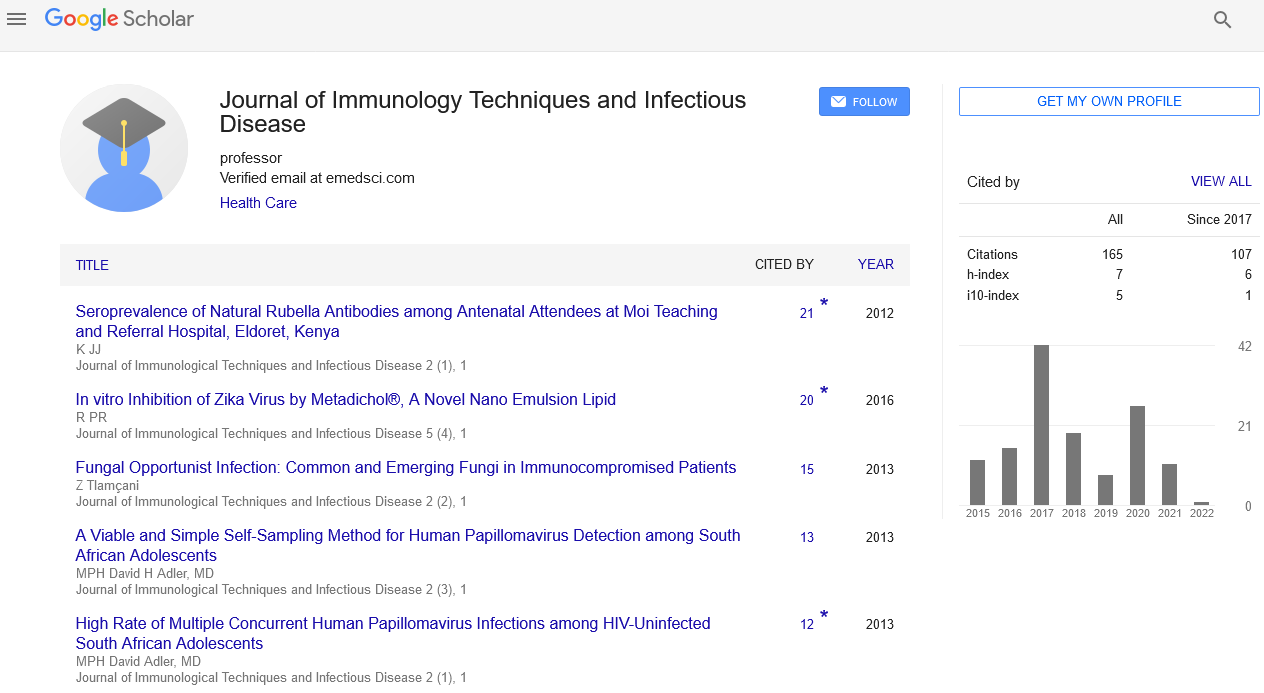Opinion Article, J Immunol Tech Infect Dis Vol: 11 Issue: 1
Assessment of Hematological Parameters in Typhoid Fever
Daniele Roberto Giacobbe*
Department of Health Sciences (DISSAL), University of Genoa, Genoa, Italy
*Corresponding Author:
Daniele Roberto Giacobbe
Department of Health Sciences (DISSAL), University of Genoa, Genoa, Italy
E-mail:daniele.roberto.giacobbe@gmail.com
Received date: 10 January, 2022, Manuscript No: JIDIT-22-51459;
Editor assigned date: 13 January, 2022, Pre QC No. JIDIT-22-51459(PQ);
Reviewed date: 24 January, 2022, QC No. JIDIT-22-51459;
Revised date: 31 January, 2022, Manuscript No. JIDIT-22-51459(R);
Published date: 11 February 2022, DOI: 10.4172/2329-9541.1000179;
Abstract
Typhoid fever acute and unspecified infection of the reticulo endothelial system, caused by Salmonella typhi, and causes substantial hepatic complications and biochemical changes. Currently, the diagnostic test is isolation of bacteria from blood, stool, and rarely urine, but serologic tests are still commonly used. There is still a need to introduce rapid and reliable test for typhoid fever. The main purpose of this study was to determine the hematological variations in adult typhoid patients as compared to healthy control. A total of 50 patients and 50 healthy individuals were enrolled in this research, and variations in hematological factors were studied. Hematological parameters were found deranged in typhoid fever including hemoglobin (low, 10.97 ± 0.88), hematocrit (low, 37.72 ± 1.40), ESR (high 45.08 ± 13.42), platelet count (high 588840 ± 97185), WBCs count (high 38267 ± 22279), neutrophil percentage (high, 73.56 ± 9.96), lymphocyte percentage (low, 21.24 ± 10.08), and NLCR (high, 5.14 ± 4.00) as compared to healthy control group. This differentiating pattern is easy to obtain by minimal invasive procedure and can be used for typhoid infection diagnosis.
Keywords: Typhoid; Leukocytosis; NLCR; Thrombocytosis; Hematological parameters; Diagnosis
Introduction
Typhoid is caused by consuming contaminated food and impure water; by the urine or feces of infected carrier [1]. When a person is infected with typhoid he seems to have fever, abdominal pain, relative bradycardia, headache, and splenomegaly [2]. Classical duration of disease is 4 weeks and after this duration condition start changing to normal. In the first week acute symptoms like toxemia, constipation and high fever occur, and severe condition like diarrhea in the second week, and more severe and highly attention gaining conditions splenomegaly, bone marrow findings and some other complications such as perforation and intestinal hemorrhage are seen in the third week [3].
Typhoid is a chief reason of morbidity and mortality throughout the world, causing an approximately 16.6 million new infections and 600,000 deaths per year. In Asia almost death rate is 80% and in Pakistan morbidity of typhoid is relatively high and needs public health interventions. Hot months have higher incidence of typhoid, and now although incidence of typhoid fever has been decreasing, but sporadic outbreaks continue to occur still [4-6]. It is estimated that number of new cases of typhoid is around 27 million and it happen with mortality around 200,000 mostly in south, central and southeast Asia. In typhoid disease transmission is human host-limited and high hazard for disease is more prevalent in low-and center salary based nations where typhoid causing Salmonella is endemic, and that have poor sanitation system, and absence of access to safe food and water [7]. The major way of spreading this infection is contamination with human faces and the typical vehicle is sullied water, nourishment, desserts, crude organic products, vegetables, squeezes, and contact with contaminated carriers or patients [8].
This disease has incubation period of 7 to 14 days and the most predominant symptom is fever [9]. It is seen that most of the serotypes of typhoid infections are detected purely on clinical grounds and treated on the base of presumptions. Laboratory capability is limited in many areas where there this disease is endemic and it makes difficult to diagnose typhoid fever clinically, as the presentation of this disease is diverse and usually similar to those observed in other febrile illnesses [10]. In laboratory typhoid fever diagnosis requires purification and then identification of Salmonella enterica serotype typhi. Isolated Salmonella from blood, urine or stool is the most trustworthy mean of confirming the infection, and the most standardized diagnostic method is blood culture and it can be positive in 60%-80% of the cases. However, in our country, patients often take antibiotics before proceeding for laboratory investigations, so the bacteria isolated from the blood cultures is only 40% to 60% of the typhoid cases. Possibility of blood culture positivity decreases with the time being; it is highly positive in first week but after that it goes low positive and becomes negative in the fourth week. Stool culture is likewise an essential aid for diagnosing typhoid fever; it might be performed to certain when blood culture is negative. Culture of the upper gastrointestinal tract utilizing a duodenal string can be important yet the procedure is ineffectively endured by youthful youngsters.
Hematological derangements are common in typhoid fever, which can be used to diagnose and assess the prognosis of this condition. So in this study our aim is to compare the hematological findings among typhoid patients and healthy individuals, and come up with some differentiating parameters that can be used as diagnostic markers for typhoid fever.
Ethylene Diamine Tetra Acetic Acid (EDTA)
In this study 100 individuals were included; 50 with typhoid fever and 50 healthy individuals as control group. This study contains confirmed typhoid patients, and typhidot test was performed to confirm typhoid fever. Venous blood of these 100 subjects was collected into both Ethylene Diamine Tetra Acetic Acid (EDTA) containing vacutainers for plasma and plain vacutainers without anticoagulant for serum. Individual patient consent was not taken because all data was retrospectively retrieved through the Laboratory Information System (LIS). EDTA anticoagulated blood samples were used for analyzing full blood count while the serum samples were used for diagnosis of typhoid fever in patients. We centrifuged the blood samples without anticoagulant at 6000 rpm for 10 min at 4oC, and the serum was aliquoted to reduce the breakdown of the proteins in the serum, the then immediately specimens were placed and remained frozen at -20°C till further processing.
Blood Culture and Antimicrobial Susceptibility Testing
For blood culture technique, 5 ml of patient's blood was inoculated to blood culture bottle filled with blood culture medium, and were incubated at 37°C for next 7 days. After 48 and 72 hours by manual method, the broth was subcultured on MacConkey agar and blood agar. Next day gram stained was used for isolates and these isolates were recognized by standard biochemical methods (Urease, TSI, SIM and Citrate). As a result, presence of typhi strains known as positive and if there is no typhi strain present it will be known as negative. Modified Kirby-Bauer disk diffusion method was the method used for antimicrobial susceptibility investigation. Strains are resistant to trimethoprim and ampicillin, and following antimicrobial agents (zone size for sensitive) were used: Gentamicin (15 mm), tetracycline (19 mm), ampicillin (17 mm), ceftriaxone (21 mm), chloramphenicol (18 mm), ofloxacin (16 mm), ciprofloxacin (21 mm), nalidixic acid (19 mm), and norfloxacin (17 mm).
Serum was evaluated by using TyphiDot (CTK) rapid diagnostic kit. Patient serum, plasma, or heparinized whole blood is used to find out the antibodies IgG or IgM via typhi dot technique.
In conclusion, typhoid fever affects hematological parameters significantly. WBCs count, ESR and platelet count were above the normal range. Hemoglobin and hematocrit was below the normal value. Neutrophil percentage was found high and lymphocyte percentage was found low in typhoid fever as compared to healthy control, resulting in high NLCR in typhoid fever patients. This differentiating pattern of hematological parameters is easy to obtain by minimal invasive procedure and can be used for the diagnosis of typhoid fever.
References
- Yasin N, Jabeen A, Nisa I, Tasleem U, Khan H, et al. (2018) A review: Typhoid fever. J Bacteriol Infec Dis 2: 1-7. [Crossref], Google Scholar], [Indexed]
- Willke A, Ergonul O, Bayar B (2002) Widal test in diagnosis of typhoid fever in Turkey. Clin Diagn Lab Immunol 9: 938-941. [Crossref] [Google Scholar] [Indexed]
- Olsen SJ, Pruckler J, Bibb W, Nguyen TMT, Tran MT, et al. (2004) Evaluation of rapid diagnostic tests for typhoid fever. J Clin Microbiol 42: 1885-1889. [Crossref] [Google Scholar] [Indexed]
- Rowe B, Ward LR, Threlfall EJ (1997) Multidrug-resistant salmonella typhi: A worldwide epidemic. Clin Infect Dis 24(Supplement_1): S106-S109. [Crossref] [Google Scholar] [Indexed]
- Buckle GC, Walker CLF, Black RE (2012) Typhoid fever and paratyphoid fever: Systematic review to estimate global morbidity and mortality for 2010. J Glob Health 2: 010401. [Crossref] [Google Scholar] [Indexed]
- Luby SP, Faizan MK, Fisher-Hoch SP, Syed A, Mintz ED, et al. (1998) Risk factors for typhoid fever in an endemic setting, Karachi, Pakistan. Epidemiol Infect 120: 129-138. [Crossref] [Google Scholar] [Indexed]
- Rasul F, Sughra K, Mushtaq A, Zeeshan N, Mehmood S, et al. (2017) Surveillance report on typhoid fever epidemiology and risk factor assessment in district Gujrat, Punjab, Pakistan. Biomed Res 28: 6921-6926 [Crossref], [Google Scholar]
- Raffatellu M, Wilson RP, Winter SE, Bäumler AJ (2008) Clinical pathogenesis of typhoid fever. J Infect Dev Ctries 2: 260-266. [Crossref] [Google Scholar] [Indexed]
- Olopoenia LA, King AL (2000) Widal agglutination test-100 years later: Still plagued by controversy. Postgrad Med J 76: 80-84. [Crossref] [Google Scholar] [Indexed]
- Ifeanyi OE (2014) Changes in some haematological parameters in typhoid patients attending university health services department of Michael Okpara university of agriculture, Nigeria. Int J Curr Microbiol App Sci 3: 670-674 [Google Scholar] [Indexed]
 Spanish
Spanish  Chinese
Chinese  Russian
Russian  German
German  French
French  Japanese
Japanese  Portuguese
Portuguese  Hindi
Hindi 
